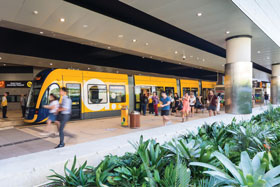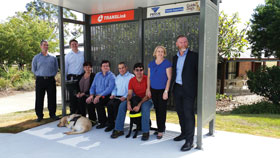The ‘at the stop’ stage of a public transport journey involves a person's experience at the stop, station or terminal, from their arrival until they board the vehicle or conveyance. During this stage they:
- enter the stop/station or terminal
- configure information about their journey
- access ticketing, retail or other facilities
- navigate their way to their platform or boarding area
- wait for their service
- board the public transport vehicle or conveyance.
Public transport stops/stations/terminals can be as simple as a sign or stop marker at the side of a road, or complex as a multi-modal interchange where many services converge.
People with disability have highlighted issues at this point in the journey, including:
- lack of shade to wait under
- space issues associated with mobility devices
- visual and audio ‘clutter’ associated with advertising or general street/road signage
- issues around identifying and hailing their service
- late changes to platforms
- difficulty in boarding a public transport vehicle.
In larger transport premises such as airport terminals and interchange rail stations, moving between drop-off points and boarding points can be a particularly difficult.
Aspirations for this journey part
- The stop/station/terminal should be easy to identify through visual and audio messaging, easy to access, provide information about services in a variety of formats, and provide a safe, suitable boarding point for users.
- Public transport users need to locate boarding points from drop-off points and surrounding infrastructure at allotment boundaries.
- Travellers should be safe and comfortable while waiting at the stop/station/terminal for their service.
How can we achieve this?
3.3.1 Consistency
People with disability have highlighted that consistency within the built environment helps accessibility. If parts of a stop/station are generally consistent with other stops/stations, they are more likely to safely and efficiently navigate the location because they are predictable and reliable. This doesn"t mean a ‘cookie cutter’ approach should be taken to planning and designing stops/stations/terminals, but consistency should be a key element in the design process.
3.3.2 Amenity considerations
People with disability have reported waiting at a public transport node for longer periods of time because they arrive earlier to ensure they can meet their service with the least amount of stress. They sometimes have to wait for more services than planned if the public transport vehicle isn"t accessible when it arrives (this is especially relevant to buses and trams in some locations around the country).
Depending on the location and local climate, this may mean waiting in the hot sun or pouring rain, so some form of shelter needs to be considered. Other amenity considerations (depending on the scale of the stop/station) should include seating, drinking water and bathrooms. This will be of increasing importance as future changes in climate occur.
3.3.3 Real time information
Where relevant and possible, real time information about upcoming arrivals should be provided at the stop/station in a variety of formats. This could be a combination of signage, audio announcements and ‘beacon’ type technology that interacts with smart devices. Journey planning apps should also access real time information so people can use this to understand the arrival progress of services.
For example, the Perth CAT bus system has visual and audio real-time information at the bus stop on the arrival time of the next bus, and Transport for NSW has been trialling ‘beacon’ type technology.
For people with hearing impairments, there should be visual indications of the arrival of a train or bus, particularly in high traffic situations such as larger train stations. For example, whenever a train approaches a platform, flashing lights could indicate the train's imminent arrival.
3.3.4 Hailing arrangements
Hailing a public transport vehicle can be difficult for people with disability, especially those who are blind or have low vision. Hailing points, including taxi ranks, should be easy to identify through a variety of formats and in line with the Transport Standards.
For example, Transport Canberra has made bus hailing kits available for passengers who are blind or have low vision. The kit consists of a clear plastic pouch with three slots and a set of numbered inserts, which used together display the required bus route number to bus drivers. The inserts have large, raised print and Braille to help with identification. In some overseas cities, buses broadcast their number and destination through a speaker mounted on the outside of the vehicle. At Brisbane busway station platforms, people who are blind or who have low vision can use the platform's emergency phone on the platform to contact the bus control room. Their needs are then communicated to the driver of the required bus service.
Drivers should also be trained to recognise when a traveller might be blind or have low vision (for example, a person using a mobility cane or guide dog), or if they have a physical or mobility disability which affects their capacity to hail a bus34. Drivers need to be vigilant and alert for these travellers, and to stop even if they are not hailed.
3.3.5 Drop off/pick up points
People with disability will often use taxis to travel to their chosen stop, station or terminal. Consideration should be given to creating a drop off/pick up point with access to the public transport node. This may include locating the area a suitable distance from the public transport node, providing an accessible route (including level footpaths, kerb ramps, wayfinding information and cues), and considering how ticketing, security and other activities at the stop/station/terminal may impact a person's journey to the public transport node.
It is important to ensure the built environment provides curb ramps near taxi ranks, bus stops, and the taxi/vehicle drop-off/pick-up areas at transport interchanges to enable wheelchair users to travel between the footpath and road. ‘No-stopping’ zones should take into account that people with disability often need to be assisted by taxi or other drivers, especially in situations where motorised mobility devices need to embark or disembark.
3.3.6 Customer service
People with disability highlighted the importance of having customer service staff available to assist them, especially in busy, complex environments. Such staff need to be well trained and able to provide information about the accessibility of the location.
For example, this is important for people with disability when they arrive independently at the entry to a terminal or large interchange station (e.g. by taxi or bus), and need to reach the check-in or boarding point. At airports, collaboration is needed between the arriving vehicle operator, the terminal operator and the airline.
There are examples in retail and banking where the customer service model has shifted to a concierge model. This means people are offered individualised service at the start of their interaction, rather than people seeking customer service staff when they have an enquiry. This is a model that could also be considered for busy stop/stations and airport terminals.
Service staff should be easily identified by their uniforms and should be located in consistent and accessible locations within the stop/station, for example at a customer service point.
For stops/stations that aren"t staffed, help points should be available for more than just emergency situations, and clear contacts provided for those who need help and assistance. These details should also be provided in Braille for customers who are blind or have low vision.
3.3.7 Consider advertising's impact on accessibility
Advertising is common at public transport nodes. For people with disability, this sometimes impacts their capacity to access wayfinding information and see approaching public transport vehicles.
For example, audio-based advertising and other sounds can make hearing station announcements difficult. In placing advertising, consideration should be given to its appropriateness and positioning in terms of safety and accessibility for those with disability.
3.3.8 Ticketing
While some people with disability carry travel cards that serve as a valid travel ticket, others have to purchase tickets or validate their travel card.
Electronic ticketing systems have advantages for transport providers in terms of efficiency and planning, and can help better meet customer needs through journey analysis information. These systems can increase customer convenience and independence35. Examples include the “go card” (Queensland), Opal (New South Wales), SmartRider (Western Australia) and myki (Victoria) cards. There is also a strong demand for a national integrated electronic ticketing system that could facilitate access to disability related concessions when travellers are interstate. A national pass system also could be used as a form of access key technology for specific needs of the user, such as locked toilets.
However, some people prefer or need to hold a paper ticket36, although the decreasing number of ticket booths may create barriers for paper ticket users in the future. Where this is the case, public transport service providers should consider familiarisation and training sessions for people who are switching to this form of ticketing to help them understand how to use and top-up (including setting automatic top-up) their travel cards. There may also be opportunities for transport service providers to partner with organisations that support people with disability in this area.
The Adelaide Metro website has a series of videos that introduce its new smartcard ticketing system. The information in these is provided in a range of formats including spoken, plain English, subtitles, pictures and photographs with on-screen Auslan interpreting of all content. These multiple formats cover a wide range of information needs (see figure 2).
| G:Link—Gold Coast light rail Every service and every station caters for passengers of all mobility levels. When trams pull into a station the door entry is almost level to the platform, though this can alter a few centimetres depending on the number of people on board the tram. The platform and trams have been designed to make it as easy as possible for everyone to board and exit at the platform. Ramps are still available for passengers who feel more confident using them or who need them to board and disembark. |
 Figure 7—G: Link tram. Image supplied courtesy of TransLink, Department of Transport and Main Roads |
| Training bus stops Guide Dogs Queensland's facility at Bald Hills has three replica TransLink bus stops. These are used to familiarise and build the confidence of people who are blind or who have low vision and their guide dogs. This is a good example of pre-journey planning focused on building an individual's confidence and capacity. |
 Figure 8—TransLink training bus stop at Guide Dogs Queensland © Guide Dogs Queensland |
| Try before you ride Public Transport Victoria holds an annual ‘try before you ride’ event to allow people of all abilities to familiarise themselves with its transport system and infrastructure. This includes people with disability, parents with young children and elderly users. Participants have a chance to boost their confidence by practicing how to board and alight a low-floor tram, low-floor bus, train, coach and accessible taxi at the Box Hill Interchange. |
 Figure 9—Try before you ride flyer |
34 Vision Australia Submission on the draft guide.
35 Department of Transport and Main Road (Qld) submission to the draft guide
36 Carers NSW and Carers Victoria submission on the draft guide.